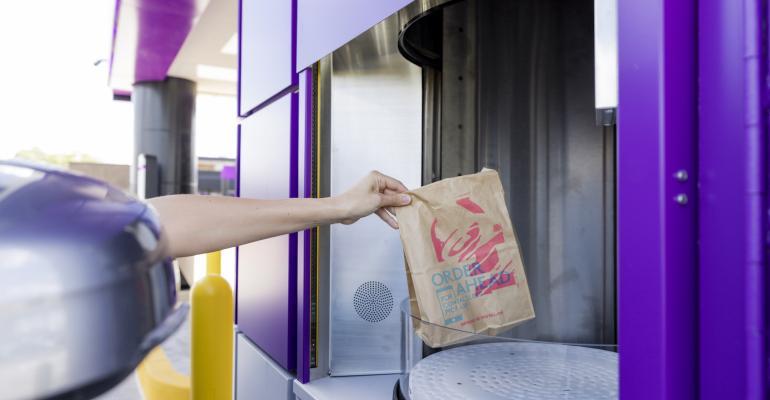We’ve tried to articulate the state of the consumer for about a year now and more signs are starting to show of a pullback on discretionary spending. That said, consumers have largely shown a sustained willingness to spend their money at restaurants and on experiences. Perhaps that explains why operators are bullish about finding real estate. According to Emily Durham, senior vice president, brokerage, food and beverage advisory at commercial real estate company JLL, demand on the restaurant real estate side is “through the roof.” In Houston, for example, there is only a 4% commercial vacancy rate.
“There are segments down in sales, but there is no shortage of people wanting to come to the market,” she said during a webinar Wednesday titled “The State of Restaurant Real Estate” hosted by data company Placer.ai. She presented alongside RJ Hottovy, head of analytical research at Placer.ai.
The two agreed the demand is a bit of a head scratcher given the overall decline in restaurant traffic and pressured macroeconomic environment, but zoom in a bit and each segment and each market tell a different story. A good example here is the specialty coffee segment, which has experienced positive traffic trends throughout the past two months while all other segments were negative. Further, in 2022, the segment outpaced every other segment, and by a lot.
“I’ve never seen so many coffee users in a market ever,” Durham said. Indeed, according to our Top 500 report with Datassential, sales in the limited-service coffee segment grew by over 12% from 2021 to 2022.
Durham and Hottovy believe a few factors are driving strength in this category, including a pandemic-induced shift toward late-breakfast/early lunch business versus just an early morning occasion, and the movement toward mobile and drive-thru usage, which has increased convenience but reduced dwell times in the segment. The shift toward mobile and drive-thru usage has also had a material impact across the broader real estate industry.
“More people are looking for double drive-thrus. Double drive-thrus were never a thing before, but now it’s smaller buildings and larger drive-thrus,” Durham said, adding that not only is there more demand for drive-thrus, but for drive-thrus with two, three or more lanes. Shake Shack is a good case study as to why this demand is growing so swiftly. According to Placer.ai data, the chain’s Orlando drive-thru location has consistently and significantly outpaced its traditional location in the market since opening in March 2022.
Hottovy said Placer.ai’s most recent numbers show that drive-thrus now make up about 70% of total sales for QSR and coffee concepts, compared to about 60% pre-pandemic. Because of this uptick, both Durham and Hottovy opined that there should be changes in rent structures.
“The traditional metric (for rent) is per square foot, so as technology increases and our buildings get smaller, it needs to change. We’re no longer working on the same metrics,” Durham said. “The interest is not going to wane anytime soon.”
Hottovy adds that as more fast casual concepts also start to adopt drive-thru formats, the line between the segment and quick-service seems to be blurring.
“Pre-pandemic, fast casual had a different perception, maybe with better quality or ingredients. The visits per location significantly outperformed, but as we got to the pandemic, we started to see QSR take over. In response, we saw things QSR brings to the table, like multiple drive-thrus, mobile ordering. They’re pretty much the same at this point,” he said.
Where we’re seeing another shift in restaurant real estate is in the move toward the Southwest and Southeast markets, which have experienced explosive growth throughout the past several years. This growth is a big reason brands like McDonald’s and Portillo’s are planting more flags in those markets.
“During Covid, we saw population shifts to the Sunbelt states whether for weather, business climate, or another reason. A lot of it was the ability for restaurants to do business; some areas were easier than others,” Durham said. “What happened is we no longer have just local Texas folks expanding through Texas, we have people coming from California and other states to try Texas. So, we have operators from other states and countries adding to the demand.”
Also, smaller markets are becoming more attractive. Hottovy said when Chipotle goes into a market with less than 100,000 people, there are a lot more visits per location, which makes such a strategy more attractive.
“It makes sense – there’s less competition, more access to labor. People want to work for these big brands coming into smaller markets. It’s cheaper to operate,” he said.
“That’s why we’re having this conversation a lot, it’s cheaper to operate. You hit the nail on the head,” Durham added. “We just need to spend more time running those numbers to look for alternative sites. A lot of it is helped by people who have moved outside of cities.”
According to the Economic Innovation Group, 2 million people moved away from cities into suburban and rural markets from 2020 to 2022.
Contact Alicia Kelso at [email protected]

